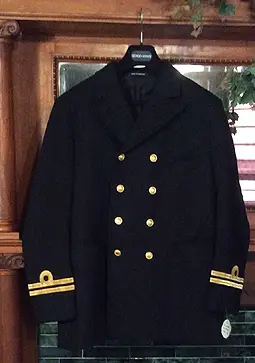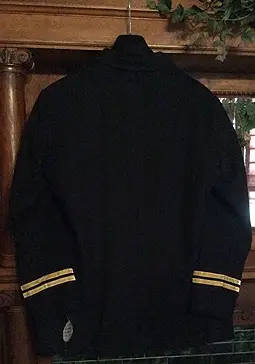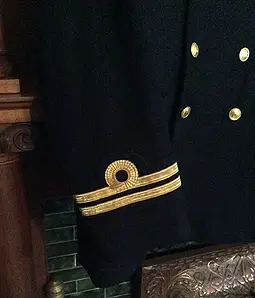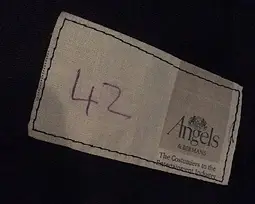White Star Line Officer's Uniforms
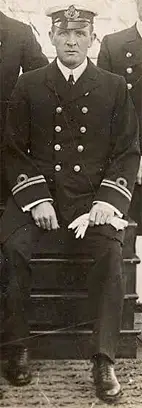
Since many deck officers had a navy background and wore uniforms based on navy regulations it should not be surprising that the White Star Line had a strict uniform code for its captains and officers. For example, First Officer Murdoch was also a Lieutenant, with the initials "RNR" frequently listed after this name to indicate that he was in the British Royal Navy Reserve. Indeed, uniforms worn by White Star Line officers were very similar to those worn by the British Royal Navy.
Regulations guiding the wearing of an officer's uniform were strictly guided by such documents as the Navy's 1890 Uniform Regulations or the White Star Line's "General Regulations" booklet each officer would receive. For example in the "General Regulations 1900" booklet for the First Officer of the RMS Adriatic it stipulates that "the Company's Full uniform as prescribed for the several grades is to be worn by the Commanders, Officers and Engineers and others while entering or leaving port, when embarking or disembarking passengers, and when attending Sunday Service… on other occasions the Company's undress uniform may be worn. R.N.R. Uniform is only to be worn on drill or on special occasions when ordered."
The following article will detail the uniforms Murdoch and the other officers aboard Titanic were expected to wear depending on the occasion or time of year.
1. Basic "Service Dress" or "Undress" Uniform
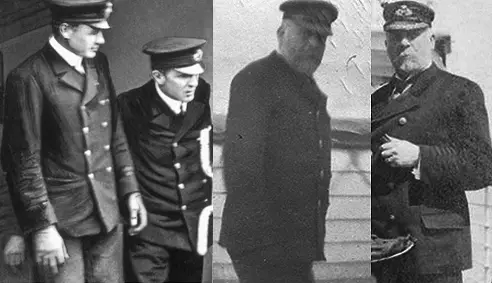
Left: Second officer Lightoller and First officer Murdoch (right) aboard Titanic, April 11th, 1912. Middle and right: Rare images of Captain Smith wearing his service uniform aboard the Baltic and Majestic respectively.
The standard "service dress" sometimes referred to as "undress", is the most basic White Star Line uniform the officers would wear when on duty, but never on formal or special occasions. Technically, "undress" refers to 'a uniform worn on other than formal occasions'. This is the uniform worn by most officers aboard Titanic. The notable features are:
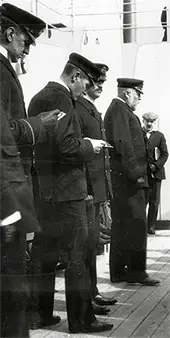
Captain Smith on the Adriatic
with his officers c. 1908/1909
in basic service dress. Credit:
F. S. Bowen collection
• Waist long jacket (Reefer jacket) double breasted eight-buttoned (sometimes referred to as a "monkey jacket").
• 8 raised White Star Line brass buttons, four to each side of the jacket, all bearing the White Star emblem.
• Material is 'navy blue' a deep, dark blue that is almost black in colour. Most often of the "Melton" variety or "naval doeskin," a smoother, finely-woven wool.
• White dress shirt, with separate collars and cuffs, with collar, turned down, black silk tie.
• Waistcoat of dark, navy blue over white cotton, or a linen bib-front shirts, buttoned down to chest level.
• Rank insignia on both sleeves using black lace with the executive curl.
• Cap worn with or without white "topper" depending on season.
2. Tropical "Summer" Uniform
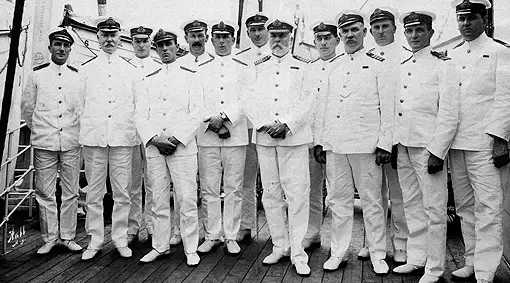
Olympic's officers in summer white uniforms. Murdoch stands second from the right.
As an alternative to the dark coloured standard uniform described above, which was normally worn during the winter months, White Star Line also had a tropical "summer" uniform, often seen in photographs taken aboard Olympic in the year before Titanic. Notable features are:
• The jacket (also refered to as a "tunic") was white, with a high "Russian" collar. Single breasted, with only a row of 5 White Star Line raised brass buttons.
• Black shoulder boards indicating rank were worn instead of cuff braid on the sleeves.
• No tie was worn and shirt would have been a sleeveless undershirt.
• Cap is worn with a white "topper" on it.
• Pants were white, and often the shoes as well.
3. Full Company Dress, "Mess Dress" Uniform
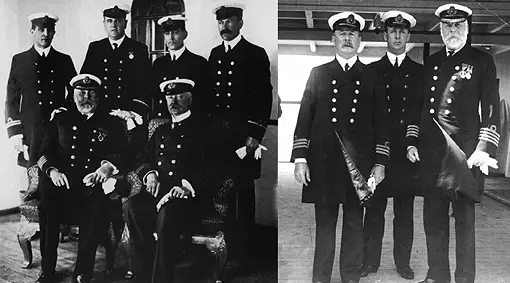
Smith posing for photographs with Olympic's officers in full company dress which seems to be the protocol for all group photographs.
For a full, more formal version of the standard "service" uniform, White Star also had a 'full company dress' also known as the "mess dress" for special occasions. The most noticeable difference is the knee-long frock jacket - rather than the shorter waist long 'monkey' jacket of the standard service uniform. Features were:
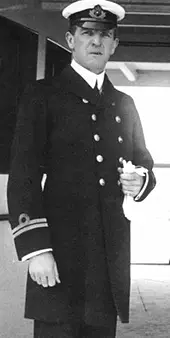
First officer Murdoch on the
bridge of the Olympic.
• Knee-long jacket (Frock jacket), with stand and fall collar, double-breasted, ten brass buttons featuring the White Star emblem in the center buttons on the front, with five gilt uniform buttons and button holes to correspond, on each side; four buttons show while the fifth button sits under the lapel, in which one button hole is worked. Also two decorative buttons on the back near the waist. Longer than the "monkey jacket", and the front rows of buttons were slightly closer to the centerline of the uniform.
• The jacket, pants, and vest were often of Navy blue Melton wool, and usually of the "doe-skin" quality.
• Shirt - White collar, turned down, white cuffs with 1 link/button.
• Waistcoat of dark, navy blue over white cotton, or a linen bib-front shirts, buttoned down to chest level.
• Necktie —Black silk, one inch wide, usually tied in a bow, but not always.
• Distinct rank insignia on both sleeves using golden lace with an executive curl.
• Cap worn with a white topper (as seen with Murdoch on the bridge of the Olympic 1911, left).
• Ceremonial gloves in white cloth
According to Titanic Style: Dress and Fashion on the Voyage By Grace Evans, "the cost, in the 1907 catalogue, for best quality captain's frock coat and trousers were £5 13s 6d and £1 10s 6d respectively."
4. Formal Court "Ceremonial" RNR Dress
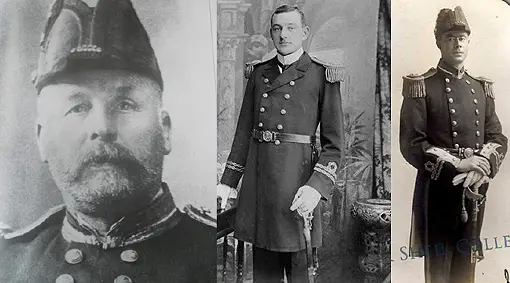
From left: Captain Smith, Wilde and Lowe in ceremonial uniforms (Lowe image credit: Inger Sheil collection)
This is the most formal, ceremonial uniform only used for very special occasions, based on the British Royal Navy Napoleonic era uniforms. Examples of when this would be used would be an awards ceremony, parade or formal portrait photograph. A good example of this is Chief Officer Wilde pictured in his ceremonial uniform in 1911 (above).
• Jacket is the same as the full company "mess dress" uniform, with tails in the back, and often more ornamental braid and buttons on the cuffs. Collar worn up.
• The shoulder boards for court dress were of the heavy gold bullion variety, with braid tasels hanging down about the outside of the shoulders.
• Old style "bicorn" hat, with white cloth gloves and often a ceremonial sword.
5. Officer's Greatcoat/Watchcoat
The Greatcoat was also known as a "watchcoat" or 'Navy Ratings Overcoat'. There are very few known photographs of a White Star officer wearing a Greatcoat. It was most notable in actor Ewan Stewart's portrayal of First officer Murdoch in James Cameron's 1997 "Titanic".
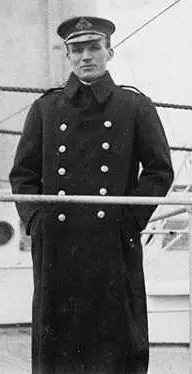
Fourth Officer Brown on the Oceanic,
19 November 1909. Credit: Bell
Album/Davison & Associates.
• Royal Navy colour and pattern with 10 buttons, five on either side (although some navy versions only have a total of 8).
• Much longer length than the standard or mess jacket.
• With a large collar that could be turned up.
• Shoulder boards to indicate rank.
• Heavy waterproof cloth, it was designed for warmth and protection against the weather.
6. Officer's Hat/Caps
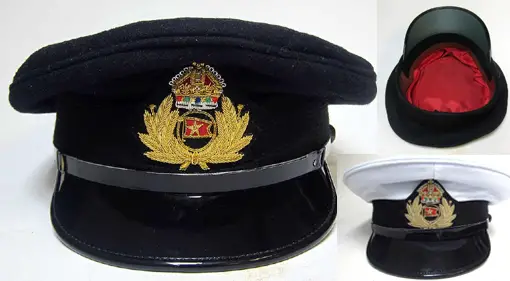
High quality reproduction officers cap, made of thick wool material which creates a 'flat top' look and comes with a removable white hat cover ("topper"). The cap is lined in red rayon. (More info: www.warhats.com)
Often the most distinctive parts of a uniform, an officer's hat had a White Star wreath/badge. The cap also had a white cover, which could transform it from navy blue to white for the Tropical/Summer uniform.
• Cap — Blue cloth, to be of the established pattern with a White Star Line wreath/badge. Chinstrap buttons are black metal. Synthetic patent leather chinstrap with double black painted brass buckles.
• Cap Cover — To be of drill, made slightly larger than the cap itself to prevent puckering it; the quarterings to be one and half inches in height, and the band one and a quarter inches deep. The mohair band and device to be worn outside the cap cover.
• Cap badge - To be made of gold bullion with a felt background and cotton reverse,
approximately 80mm wide x 65m tall and 6mm thick. There are two versions of the badge, with a new cap badge design being adopted in 1912 which had
a taller design and featuring a a circle around the burgee (see below). Smith, Wilde and Murdoch wore the old style. Moody wore the new style.
• The Captain of a vessel would also have a spray of gold bullion embroidered oak leaves set along the outer edge of the visor on his cap.
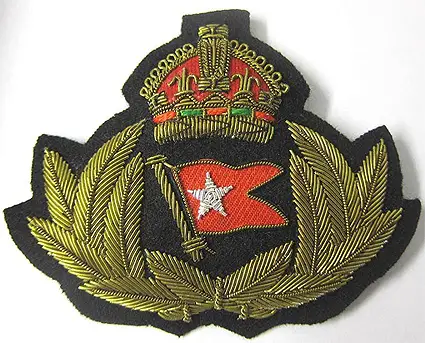
Hand made reproduction of the pre-1912 design cap badge wreath as worn by Smith, Wilde and Murdoch. It is made of gold bullion with a felt background and cotton reverse. It is approximately 80mm wide x 65m tall and 6mm thick. (More info: www.warhats.com).
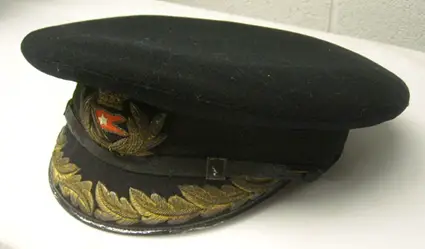
Wilde's White Star Line cap (courtesy of Merseyside Maritime Museum). The curious aspect is that the brim of the cap has oak leaves on it, which is what is used to indicate captain. This has caused some to speculate that prior to Titanic he was in fact captain.
(Click image to enlarge)
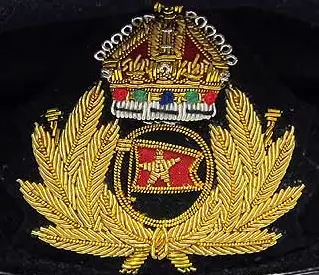
A reproduction of the new 1912 cap badge wreath as worn by Titanic's Sixth officer Moody and anyone purchasing new uniforms from 1912. It is made of gold bullion with a felt background and cotton reverse. It is taller than the older version above and featured a circle around the burgee (Image: www.warhats.com).
7. Officer's Rank
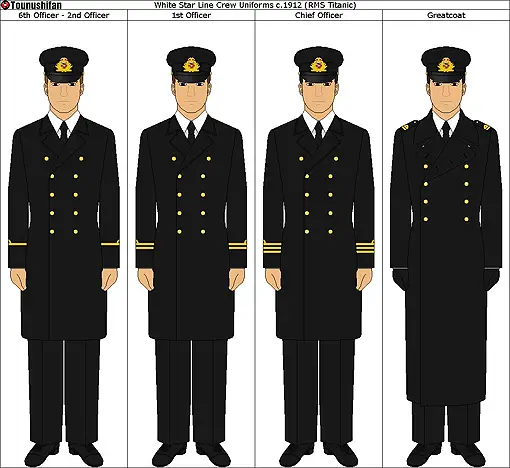
Uniforms of Titanic's officers according to rank, plus a Greatcoat. Courtesy of Grand-Lobster-King/Deviant Art (Click image to enlarge)
A White Star Line officer showed his rank using either a cuff braid (on Navy blue uniforms) or via shoulder boards. These were made using standard British Royal Navy gold bullion braid stripes.

• Three straight stripes, with a fourth "looped" executive curl, top stripe denoted the rank of Captain.
• Two rows with a third looped (executive curl) top row denoted a Chief Officer, or the Captain of a smaller vessel.
• One row with a second looped (executive curl) row denoted a First Officer.
• Second Officer and lower were denoted by a single row of looped (executive curl) braid.
• Captain was also allowed to wear a wide row of gold braid down the length of each pant leg (on the outside edge.)
According to Titanic researcher Parks Stephenson, "the 'executive curl' was worn only by the qualified deck officers; i.e., Smith, Wilde, Murdoch, Lightoller. The junior officers did not rate the curl, so their stripe would be straight. Biggest problem with costumers is getting the curl going the right way. The loop crosses over the stripe in the front. In today's RN, you owe the house a round of you put your shoulder boards on backward."
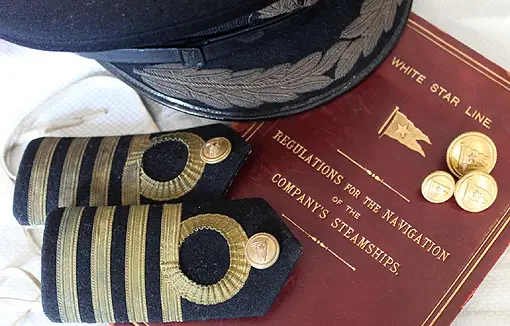
White Star Line shoulder boards, button, cap and regulations book.
(Click image to enlarge)
8. Officer's Buttons
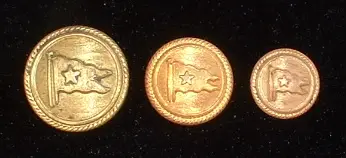
Original White Star Line officer's buttons -the largest is a gilt coat jacket button measuring 1" in diameter, the second is 3/4" and the small button measures 5/8". Image credit: titanicitems.com.
The famous White Star button was not established until 1899 as the symbol of the company with a star within a a swallow tailed burgee. Prior to that between 1871 and 1899, it changed twice. The first pattern issued in 1871 featured an American bald eagle in its beak a flag pole displaying the White Star Line burgee with the letters O.S.N.C. above for Oceanic Steam Navigation Company, the official name of the White Star Line. By the early 1890s the design was altered with the name in a garter belt surrounding a five pointed star, before settling on the final design in 1899.
There were three main types of buttons - gilt coat jacket button measuring 1" in diameter, the second is 3/4" and the small button measures 5/8". The large being used on heavy overcoats such as the officer's greatcoat, the smaller on jackets or vests.
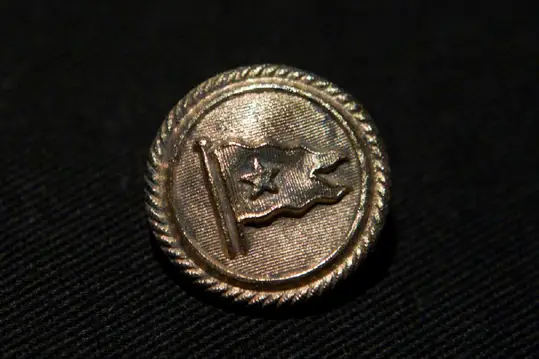
A uniform button belonging to William Murdoch.
(AP Photo/David Goldman, click image to enlarge)
9. Tailors and Suppliers
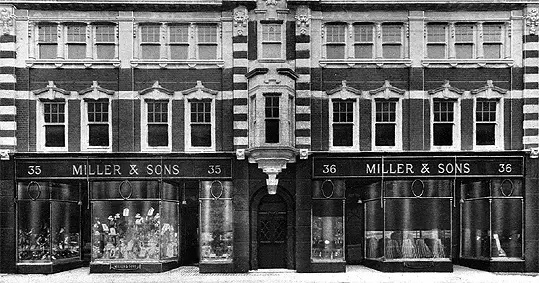
Miller and Sons in Southampton supplied many of the White Star uniforms and buttons in 1912. Image: Miller, Rayner, Haysom Ltd (click image to enlarge)
Interestingly, the White Star Line did not supply its officers with uniforms so officers had to purchase their own uniforms from approved uniform supply shops.
Miller and Son in Southampton were the tailors who often supplied many of the White Star Line uniforms for ship's based out of Southampton. Established in 1818 by George Miller the company changed its name in 1912 to "Miller, Rayner, Haysom Ltd: Naval, Military, Shipping & Colonial Outfitters" The company exists today, still supplying the British Merchanist Navy: http://millerrayneronline.co.uk/
Also, brass buttons were imported from the Waterbury's Button Company (in America), as well as from Rayner and Sons of Liverpool.
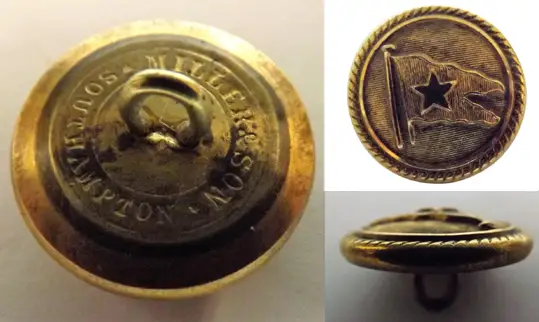
An example of an early 1900s gilt brass 1 inch button stamped "Miller & Son Southampton" on the reverse.
10. Senior and Junior Officer's Uniforms: On film
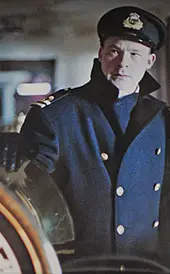
Actor Ewan Stewart as
First Officer Murdoch
in James Cameron's "Titanic".
The portrayal of First Officer Murdoch's uniform over the years has rarely been very accurate. In the 1943 German film "Titanic" Officer 'Morlock' is depicted as the Chief Officer with three stripes. This is an error later repeated in the 1996 CBS TV-movie "The Titanic".
A more accurate portrayal appeared in James Cameron's 1997 "Titanic" in which actor Ewan Stewart is correctly shown wearing the two stripes of the First Officer and later during the evacuation a large, heavy Greatcoat. The uniform was apparently created and supplied by Angels Costumes based in North London, England, a well respected company in the industry established in 1840. The uniform used by Ewan Stewart has appeared on display at various times around the world. In October 2015, one of the jackets from the costume (the costume department would have created duplicate versions) appeared available for sale on Ebay. A size 42, the inside of the jacket was labelled as "Angels & Bermans The Costumiers to the Entertainment Industry". Angels acquired Bermans (also known as Berman's and Nathan's) in 1992 and was for some time (at least until 2012) listed as Angels & Bermans Limited. Now it is known simply as "Angels The Costumiers" (website is here). Interestingly, until 1966 Angels was also the tailor to the military and diplomatic services, and so also houses a collection of military and civilian uniforms, which would indicate their First officer uniform for James Cameron's "Titanic" must be somewhat accurate.
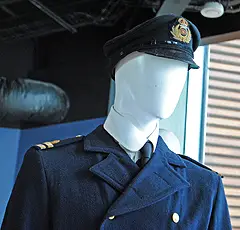
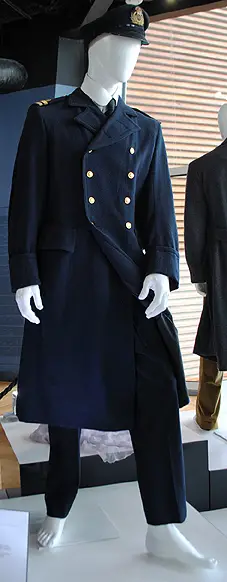
Above: Ewan Stewart's First officer uniform (Greatcoat) from the 1997 "Titanic" film on display at Belfast Titanic Museum, courtesy of Tiphaine Hirou (click images to enlarge)
Above: One of the jackets from Ewan Stewart's First officer costume from the 1997 "Titanic" film for sale on ebay (click images to enlarge)
Simon Crane's uniform for Fourth Officer Boxhall, went up for sale on Sep 25, 2019 at Heritage Auctions. It is described as: "Original (8) piece ensemble including (1) Dominic Gherardi brand navy blue double-breasted wool Reefer jacket with short collar, peaked lapel, gold metal nautical flag buttons along single back vent, gold bullion ribbon piping on cuffs, with button front closure, (1) matching wool waistcoat with 4-front slash pockets, gray wool back and gold metal nautical flag button front closure, (1) pair matching wool trousers with button front closure, (1) long sleeve white button up with short standing collar, (1) matching white button front collar, (1) black necktie, and (1) black wool officers peaked cap with black patent visor and band, with multicolor embroidered patch appliqué, interior brown leather hat band, lined in white satin. Jacket, waistcoat and pants retain internal Dominic Gherardi bias labels typed, "Simon Crane September 1996", hat shirt and collar retain handwritten, "Boxhall" in black ink. Exhibiting production wear and studio distressing, shirt with minor breach lower back with production soiling and makeup remnants. In very good condition."
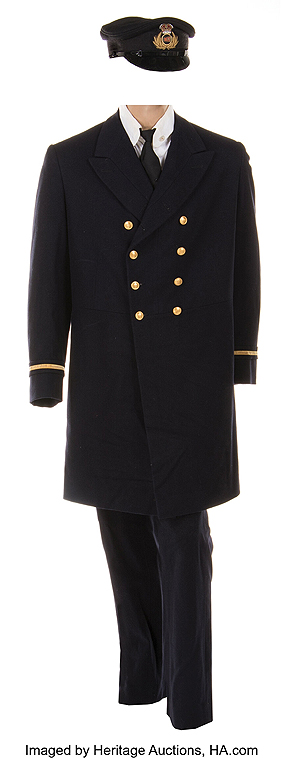
Simon Crane's uniform for Fourth Officer Boxhall, that was up for sale on Sep 25, 2019
at Heritage Auctions. (Click image to enlarge)
References, credits and thanks to:
John Hemmert/Encyclopedia Titanica
Petra Feyahn
Parks Stephenson
Inger Sheil
Tiphaine Hirou
Brian R Peterson
